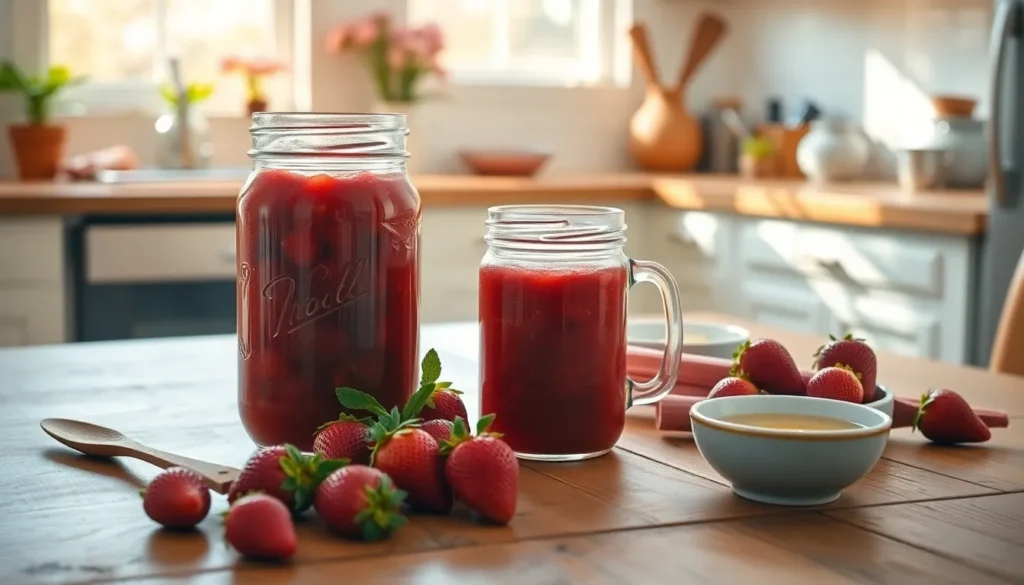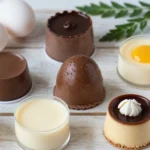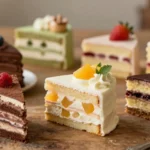Nothing beats the classic combination of sweet strawberries and tart rhubarb when it comes to homemade jam. This strawberry rhubarb jam captures the essence of late spring and early summer in every spoonful, delivering that perfect balance of fruity sweetness with a delightful tangy kick that’ll make your taste buds dance.
We’ve perfected this recipe to give you that thick, spreadable consistency that holds up beautifully on toast, biscuits, or even swirled into yogurt. The natural pectin from both fruits creates an ideal gel without needing artificial additives, making this jam as wholesome as it is delicious.
What makes our version special is the simple technique that intensifies the flavors while preserving that fresh, vibrant taste. You’ll love how your kitchen fills with the most incredible aroma as this jam bubbles away on the stove, creating memories that’ll last long after the last jar is gone.
Ingredients
We carefully selected these fresh ingredients to create our perfect strawberry rhubarb jam that balances sweet and tart flavors beautifully.
Fresh Fruits:
- 2 pounds fresh strawberries, hulled and quartered
- 1 pound fresh rhubarb stalks, trimmed and cut into ½-inch pieces
- ¼ cup fresh lemon juice (about 1 large lemon)
- 1 tablespoon lemon zest
Sweetener:
- 3 cups granulated sugar
- 2 tablespoons honey (optional, for enhanced flavor depth)
Natural Thickening:
- 1 package (1.75 oz) powdered fruit pectin
- ¼ teaspoon butter (to reduce foaming)
Essential Equipment:
- Large heavy-bottomed saucepan or Dutch oven
- Wooden spoon for stirring
- Sterilized canning jars with lids
- Candy thermometer (optional)
Our ingredient proportions create the ideal consistency without artificial additives. Fresh strawberries provide natural sweetness while rhubarb contributes that signature tart bite. We recommend using strawberries that are ripe but still firm to maintain texture during cooking. The rhubarb should have crisp stalks with vibrant color for optimal flavor contribution.
Lemon juice serves dual purposes in our recipe by preventing oxidation and improving the natural pectin activation. We always use freshly squeezed lemon juice rather than bottled versions for superior taste results. The small amount of butter helps eliminate excess foam during the cooking process without affecting the final flavor profile.
Equipment Needed
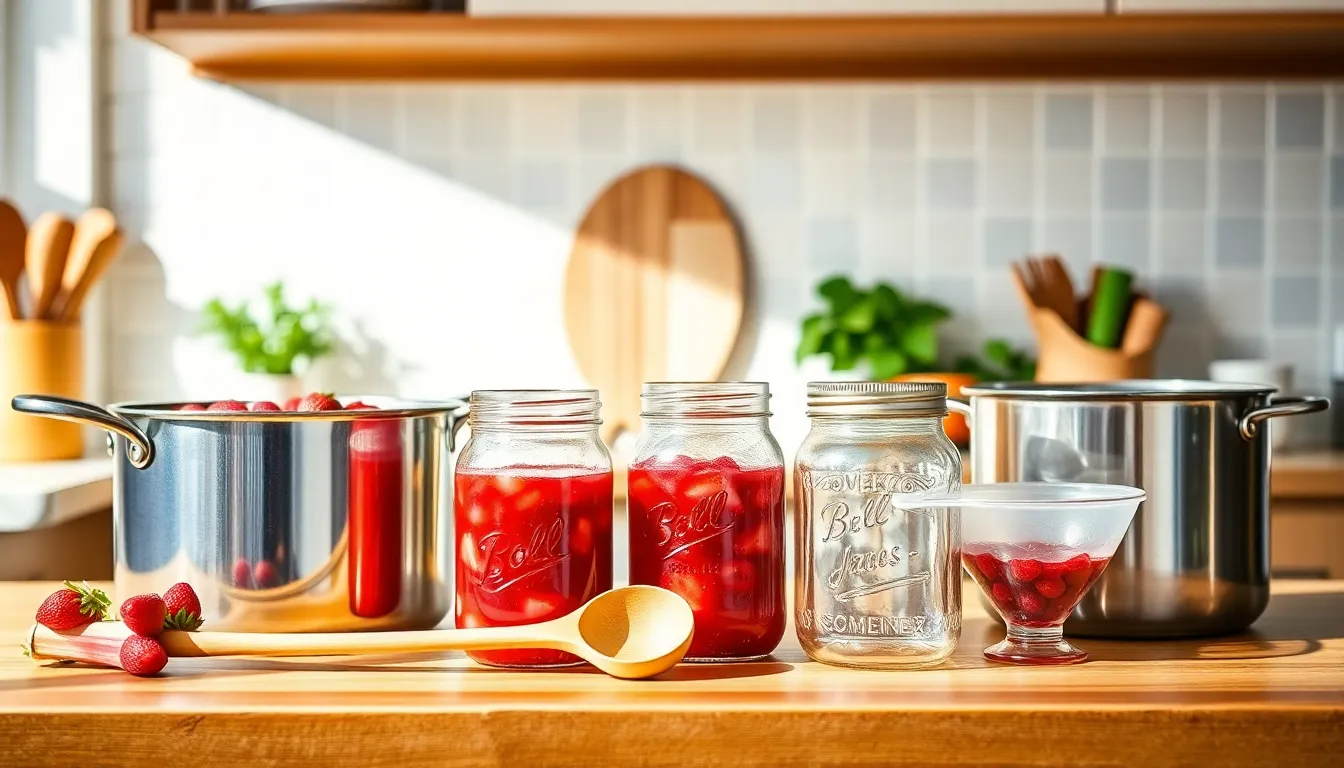
Creating perfect strawberry rhubarb jam requires the right tools to ensure consistent results and safe preservation. We recommend gathering all equipment before starting the cooking process to streamline your jam-making experience.
Essential Cooking Equipment:
- Large saucepan or heavy-bottomed pot for even heat distribution
- Wooden spoon or rubber spatula for stirring without scratching surfaces
- Potato masher or whisk for crushing fruits to your desired consistency
- Strawberry corer (optional but helpful for efficient preparation)
Canning and Storage Equipment:
- Pint-size Mason jars with matching lids for proper sealing
- Canning funnel to prevent spills and ensure clean jar rims
- Ladle for transferring hot jam into jars
- Water bath canner for safe long-term storage
The saucepan should be large enough to accommodate the fruit mixture as it bubbles and expands during cooking. Mason jars must be sterilized before use to prevent contamination and ensure proper preservation. A canning funnel becomes invaluable when filling jars with hot jam since it minimizes mess and maintains the clean rim necessary for proper sealing.
Water bath canning equipment becomes essential if you plan to store your jam for months rather than weeks. This method allows us to create shelf-stable preserves that maintain their quality and safety over extended periods.
Prep
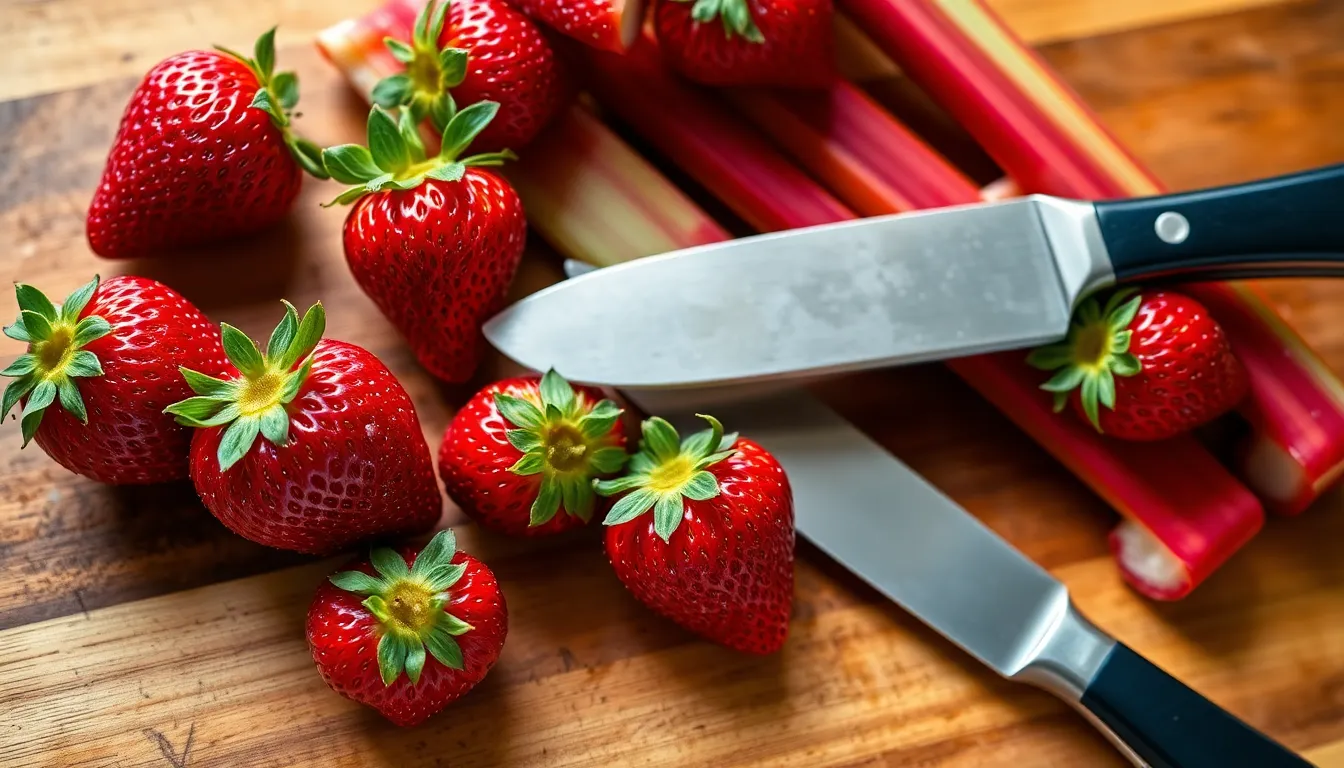
Proper preparation sets the foundation for creating exceptional strawberry rhubarb jam. We’ll walk through each essential step to ensure our fruits are perfectly prepped and our equipment is ready for safe preservation.
Preparing the Strawberries
We begin by rinsing our strawberries thoroughly under cool running water to remove any dirt or debris. Remove the green stems and leaves completely using a paring knife or strawberry huller for clean results.
Quarter the strawberries into uniform pieces to ensure even cooking and consistent texture throughout our jam. Larger strawberries may need to be cut into smaller chunks while smaller berries can simply be halved.
Place the prepared strawberries in a large mixing bowl and gently mash about half of them with a potato masher. This creates the perfect balance between chunky fruit pieces and smooth jam base that we’re aiming for.
Preparing the Rhubarb
Trim both ends of the rhubarb stalks and discard any leaves completely as they contain toxic compounds. Rinse the stalks under cold water to remove any lingering dirt or garden residue.
Cut the rhubarb into small half inch pieces using a sharp knife for uniform cooking. Consistent sizing ensures that all pieces will break down at the same rate during the cooking process.
We recommend using only the tender pink and green stalks while avoiding any woody or fibrous portions. Fresh rhubarb should feel firm and crisp when properly prepared for jam making.
Sterilizing Jars
Wash our Mason jars and lids thoroughly in hot soapy water before beginning the sterilization process. Inspect each jar for cracks or chips that could compromise the seal during canning.
Place the clean jars in a large pot and cover completely with water before bringing to a rolling boil. Boil the jars for 10 minutes to eliminate any bacteria or contaminants that could spoil our jam.
Remove the sterilized jars using canning tongs and place them on a clean kitchen towel to air dry. Keep the jars warm until we’re ready to fill them with our hot jam for optimal sealing results.
Instructions
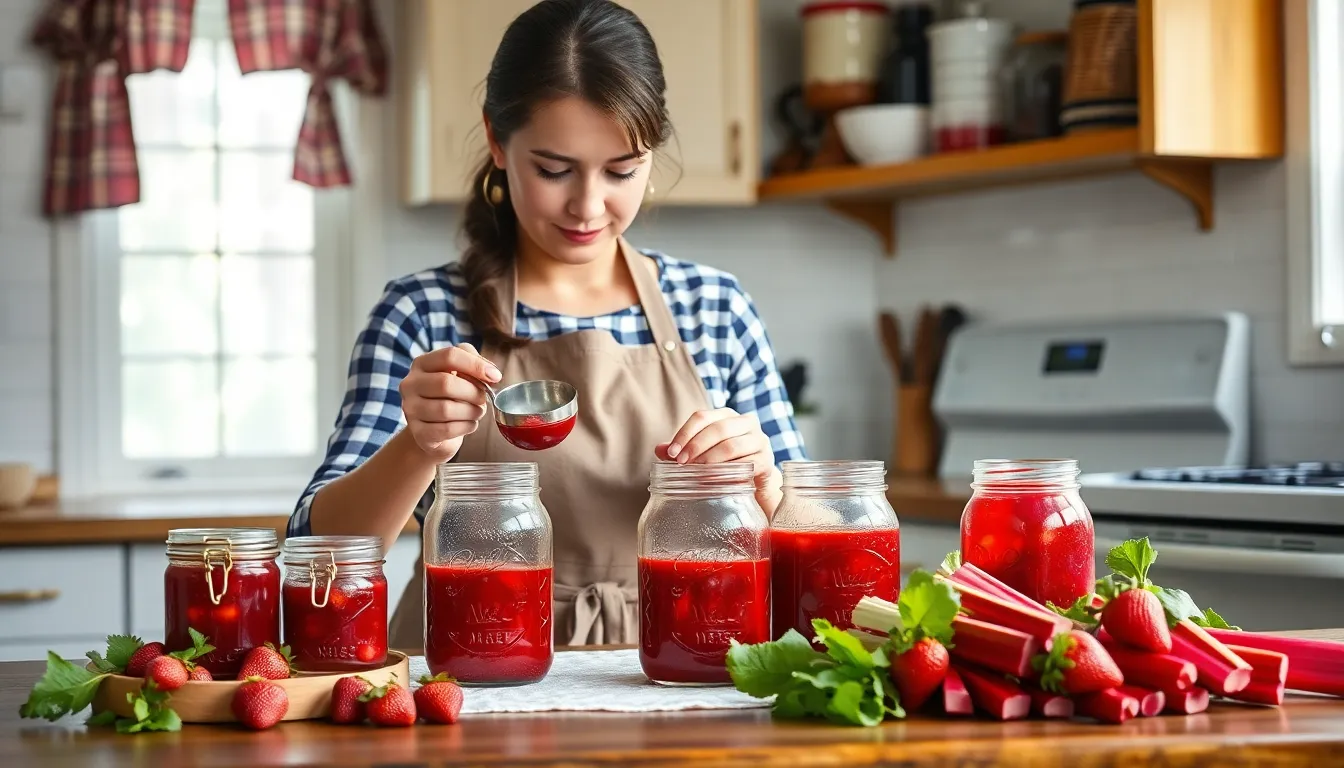
Now that we have prepared our ingredients and sterilized our equipment, we can begin transforming fresh strawberries and rhubarb into delicious homemade jam. The cooking process requires attention to timing and temperature to achieve the perfect consistency.
Cooking the Jam
We start by combining our sliced strawberries, chopped rhubarb, sugar, and fresh lemon juice in a large pot. The mixture should be stirred gently to distribute all ingredients evenly before applying heat.
Place the pot over medium heat and allow the sugar to dissolve completely while the fruit releases its natural juices. This initial heating phase takes approximately 5-7 minutes and creates the foundation for our jam.
Once the sugar has dissolved and juices begin flowing freely, we increase the heat to medium-high to achieve a rolling boil. The mixture will bubble vigorously and transform as the fruits break down naturally.
If we are using pectin, we add all the sugar at once when the mixture reaches a full boil. Without pectin, the sugar should already be incorporated from the beginning of the cooking process.
We maintain the rolling boil for exactly one minute after adding sugar when using pectin, then immediately remove the pot from heat. This precise timing ensures proper gel formation without overcooking.
After removing from heat, we stir the jam continuously for about 5 minutes. This cooling period distributes heat evenly throughout the mixture and prevents pectin from clumping together.
Testing for Doneness
The thickness test provides the most reliable method for determining jam readiness. We remove the pot from heat and place a small spoonful of jam on a chilled plate, allowing it to cool to room temperature.
When the cooled jam holds its shape and feels thick to the touch, our strawberry rhubarb jam has reached the proper consistency. If the mixture remains too thin or runny, we continue cooking until it passes this test.
The sheeting test offers an alternative method for checking doneness. We dip a clean spoon into the jam and hold it above the pot, watching how the mixture drips back down.
Properly cooked jam will form a cohesive sheet that holds together briefly before dropping from the spoon. Individual droplets indicate the jam needs additional cooking time to reach the desired thickness.
Canning Process
We begin by ensuring all our Mason jars, lids, and bands remain properly sterilized and ready for use. The jars should stay warm until we are ready to fill them with hot jam.
Using a canning funnel, we carefully ladle the hot jam into each prepared jar, leaving exactly 1/4 inch of headspace at the top. This measurement ensures proper sealing during the processing phase.
We wipe the rim of each jar clean with a damp cloth to remove any jam residue that could interfere with sealing. Clean rims are essential for creating an airtight seal that preserves our jam safely.
The lids are applied first, followed by the bands which we screw on until snug but not overly tight. Excessive tightening can prevent proper air evacuation during processing.
We process the filled jars in a boiling water bath for exactly 10 minutes to ensure complete sterilization and proper sealing. The water level should cover the jar tops by at least one inch throughout processing.
After processing, we remove the jars and place them on a towel-covered surface to cool completely. The distinctive “pop” sound indicates successful sealing as each jar cools over the next 12-24 hours.
Storage Instructions
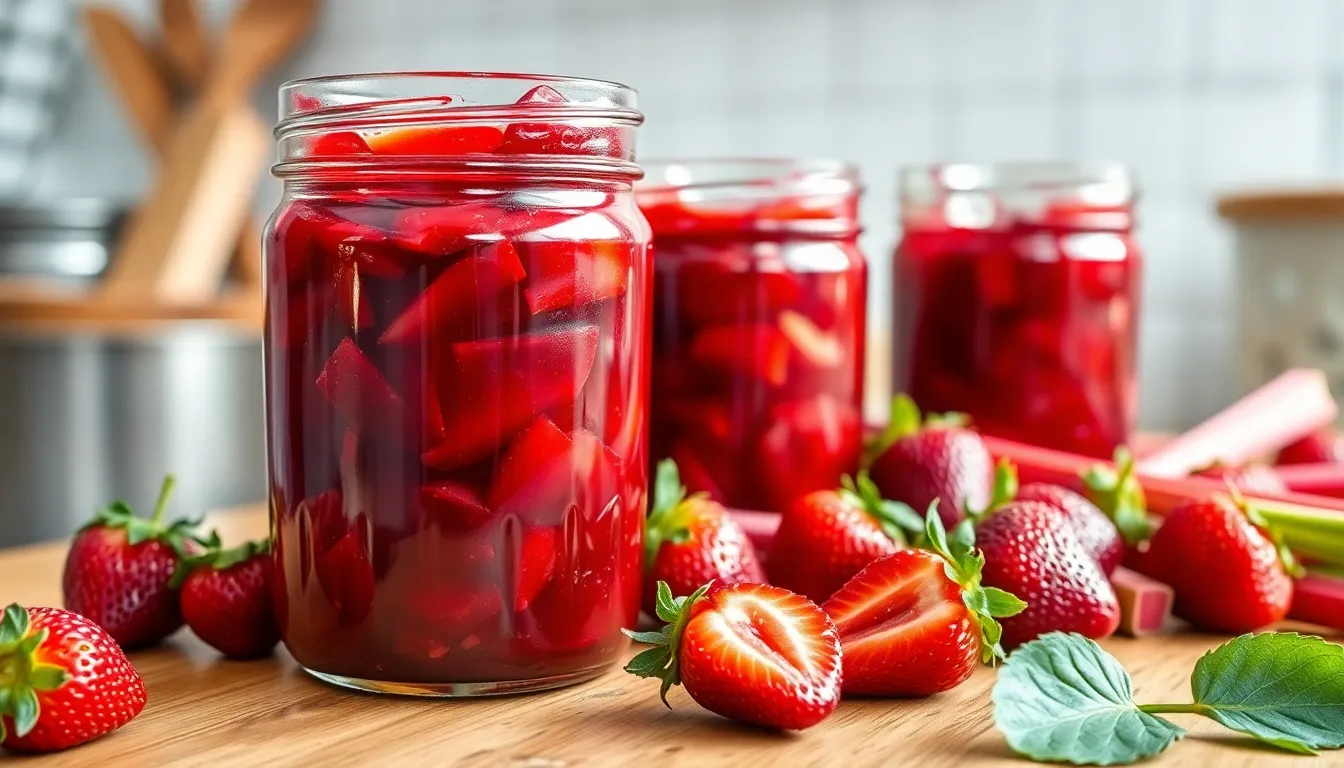
Proper storage ensures our homemade strawberry rhubarb jam maintains its vibrant flavor and quality for months to come. We’ll explore three effective storage methods that suit different preservation needs and timeframes.
Refrigerator Storage
We recommend storing opened jars of strawberry rhubarb jam in the refrigerator where they’ll maintain peak quality for 2 to 3 months. Our freshly made jam should be transferred to clean glass jars and refrigerated immediately after cooling if we’re not processing it for long term storage.
For short term consumption we can keep our jam refrigerated for 3 to 4 weeks in sterilized glass containers. The cool temperature preserves the jam’s texture and prevents spoilage while maintaining that perfect balance of sweet strawberries and tart rhubarb we worked so carefully to achieve.
Freezer Storage
Freezing extends our strawberry rhubarb jam’s life to approximately one year without compromising flavor or quality. We store the jam in freezer safe glass jars leaving adequate headspace to prevent cracking as the contents expand.
When we’re ready to enjoy our frozen jam we simply thaw it overnight in the refrigerator. This gentle thawing process maintains the jam’s consistency and prevents separation that can occur with rapid temperature changes.
Pantry Storage
Properly canned strawberry rhubarb jam stores beautifully in our pantry for up to 2 years when kept in a cool dark place. We ensure our canned jars have sealed correctly by listening for that satisfying “pop” as they cool and checking that the lids don’t flex when pressed.
Once we open a canned jar we treat it like fresh jam and store it in the refrigerator for optimal quality. Our investment in proper canning techniques pays dividends by allowing us to enjoy our homemade strawberry rhubarb jam throughout the year while maintaining food safety standards.
| Storage Method | Duration | Temperature | Container |
|---|---|---|---|
| Refrigerator (opened) | 2-3 months | 35-40°F | Glass jars |
| Refrigerator (fresh) | 3-4 weeks | 35-40°F | Sterilized glass |
| Freezer | 1 year | 0°F or below | Freezer-safe glass |
| Pantry (canned) | 2 years | Cool, dark place | Properly sealed jars |
Serving Suggestions
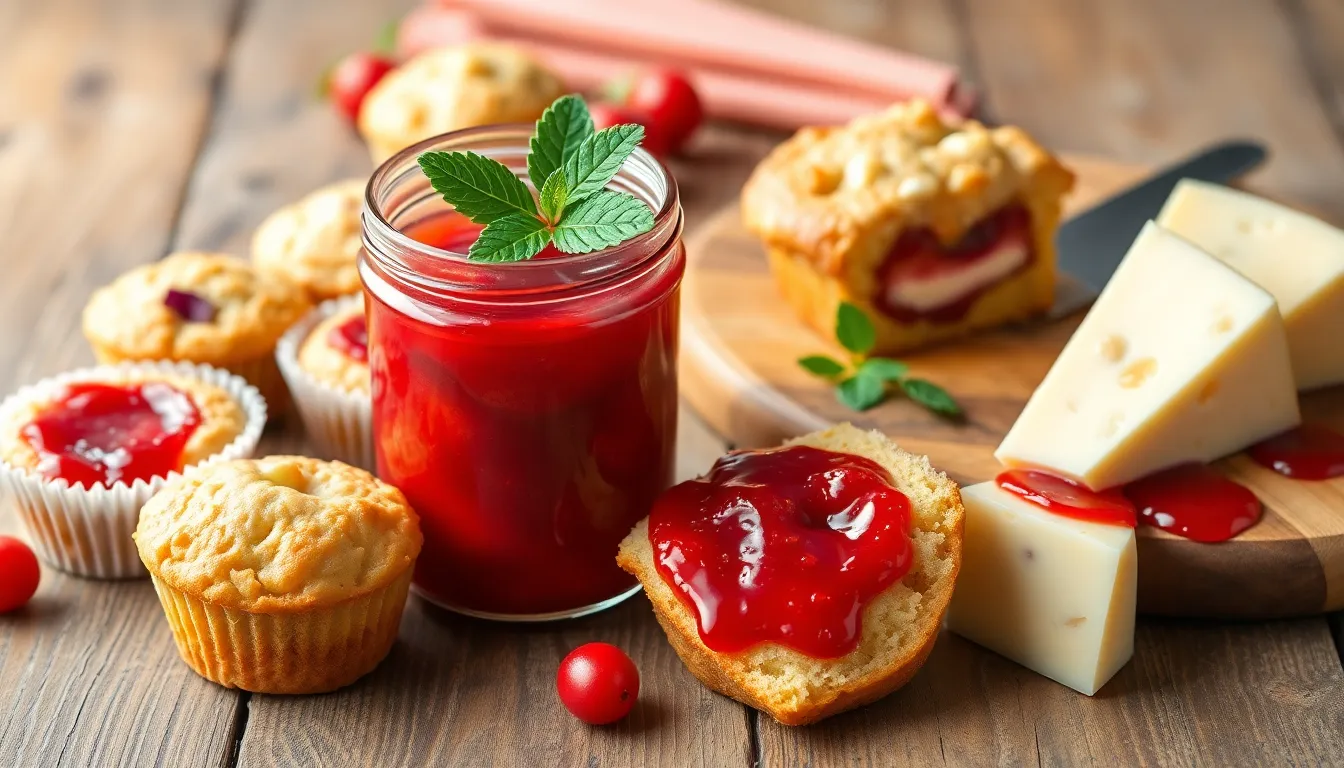
Our homemade strawberry rhubarb jam transforms ordinary meals into extraordinary culinary experiences. We recommend exploring these versatile serving options to maximize your jam’s sweet and tart potential.
Baking Applications
Pastry fillings showcase our jam’s exceptional texture and flavor profile. We love incorporating this preserve into muffin centers where the fruit pieces create delightful bursts of flavor. Layer the jam between cake layers for a professional bakery taste that impresses guests at every gathering.
Danish pastries and croissants benefit tremendously from our strawberry rhubarb filling. The natural pectin prevents excessive spreading during baking while maintaining the jam’s structural integrity. Thumbprint cookies become gourmet treats when filled with this preserve before the final baking stage.
Dessert Pairings
Ice cream toppings reach new heights with our thick spreadable jam. We suggest warming the preserve slightly to create a luxurious sauce that complements vanilla, cheesecake, or lemon flavors perfectly. Greek yogurt parfaits gain sophistication when layered with granola and generous spoonfuls of our homemade creation.
Pancakes and waffles transform into restaurant quality dishes with our jam as the star topping. The chunky texture adds visual appeal while the balanced sweetness eliminates the need for additional syrups. French toast becomes a weekend indulgence when served alongside this vibrant preserve.
Savory Combinations
Cheese boards benefit from the sweet and tart contrast our jam provides. We pair it with sharp cheddar, creamy brie, or tangy goat cheese for sophisticated flavor combinations. Crackers become the perfect vehicle for creating bite sized appetizers that guests remember long after the meal ends.
Charcuterie presentations gain elegance when our strawberry rhubarb jam accompanies cured meats. The acidity cuts through rich flavors while adding natural sweetness that balances salty elements beautifully.
Creative Cocktail Applications
Create cocktails reach new dimensions with our jam as a unique ingredient. We muddle small amounts into gin or vodka based drinks for complex flavor profiles that surprise and delight. The natural fruit sugars eliminate the need for additional simple syrups while adding beautiful color to finished beverages.
Champagne cocktails sparkle when enhanced with a teaspoon of our preserve. The bubbles carry the strawberry rhubarb essence throughout each sip while creating visually stunning presentations for special occasions.
Troubleshooting Tips
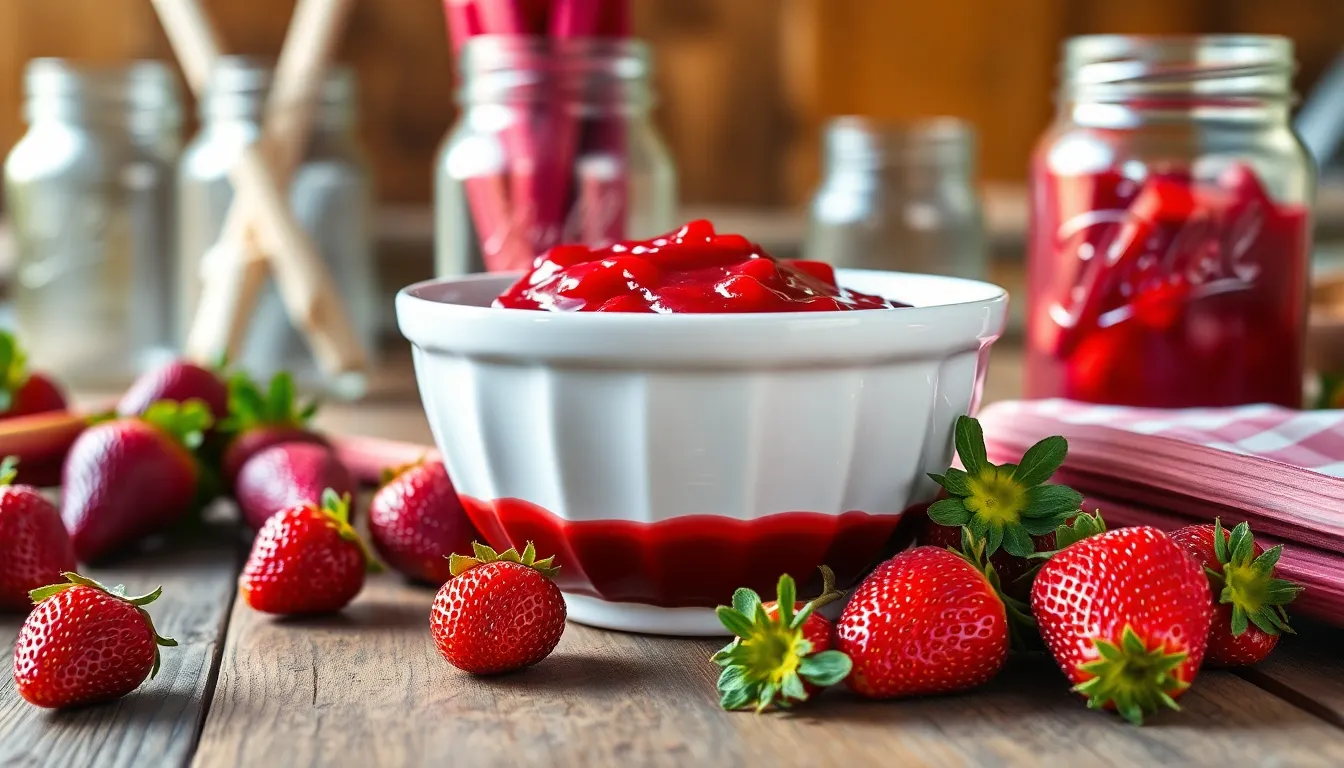
Even experienced jam makers encounter challenges during the cooking process. We’ll guide you through the most common issues and provide practical answers to achieve perfect strawberry rhubarb jam every time.
Too Runny
Excessive liquid in the fruit or insufficient pectin typically causes runny jam consistency. We recommend reheating the jam with additional sugar and powdered pectin to restore proper thickness.
For every 4 cups of runny jam, add 1/2 cup sugar and 1 tablespoon powdered pectin. Boil the mixture for 5-10 minutes while checking for thickening using the plate test. Place a small plate in the freezer beforehand, then drop a small amount of jam on the cold plate. Push the jam with your finger – properly set jam will wrinkle and hold its shape.
The jam still refuses to thicken after this treatment, consider repurposing it as a delicious syrup for pancakes or desserts. Natural fruit variations can affect pectin levels, making some batches more challenging to set properly.
Too Thick
Overcooking or excessive pectin creates jam that spreads poorly and lacks the desired consistency. We suggest diluting thick jam with small amounts of water or fresh lemon juice until you achieve the perfect spreadable texture.
Extremely thick jam requires gentle reheating with water to restore proper consistency. Add one tablespoon of water at a time while stirring continuously over low heat. This gradual approach prevents the jam from becoming too thin or developing an unpleasant texture.
Monitor the consistency carefully during this process since the jam will continue thickening slightly as it cools. Remove the jam from heat once it reaches a slightly thinner consistency than desired.
Crystallization Issues
Sugar crystallization occurs when jam heats unevenly or sugar fails to dissolve completely during the initial cooking phase. We ensure all sugar dissolves before bringing the mixture to a rolling boil to prevent this common problem.
Avoid overheating the jam beyond the necessary temperature, as excessive heat promotes unwanted crystallization. Stir the mixture gently but consistently during the initial heating phase to encourage even sugar dissolution.
Crystallization has already formed, reheat the jam gently while stirring continuously to dissolve the crystals. Add a small amount of water if necessary to help the crystals dissolve completely. Fresh, high-quality strawberries and rhubarb contribute significantly to successful jam making and help prevent crystallization issues.
Store your finished jam in sterilized mason jars and refrigerate if consuming within one week. Consider water bath canning for longer storage periods to maintain optimal flavor and texture throughout the year.
Conclusion
We’ve shared everything you need to create this exceptional strawberry rhubarb jam that’ll become a staple in your kitchen. From selecting the perfect ingredients to mastering the cooking technique this recipe delivers consistent results every time.
The beauty of homemade jam lies in its versatility and the satisfaction of creating something truly special from simple fresh ingredients. Whether you’re spreading it on morning toast or incorporating it into elegant desserts you’ll taste the difference that comes from making it yourself.
Don’t let any challenges discourage you – even experienced jam makers encounter issues occasionally. With our troubleshooting tips you’re well-equipped to handle any situation that arises during the process.
Now it’s time to gather your ingredients fire up the stove and start creating this delicious strawberry rhubarb jam that’ll bring joy to your table for months to come.
Frequently Asked Questions
What ingredients do I need to make strawberry rhubarb jam?
You’ll need 2 pounds of hulled and quartered strawberries, 1 pound of trimmed rhubarb cut into uniform pieces, fresh lemon juice, and sugar. Optional ingredients include honey for added depth and a small amount of butter to reduce foaming during cooking. Choose ripe but firm strawberries and vibrant rhubarb for the best flavor results.
What equipment is essential for making this jam?
Essential equipment includes a large saucepan, wooden spoon, potato masher, and optionally a strawberry corer. For canning and storage, you’ll need pint-size Mason jars, a canning funnel, ladle, and water bath canner for long-term preservation. Make sure all jars are properly sterilized before use to ensure safe storage.
How long does homemade strawberry rhubarb jam last?
Storage time depends on the method: opened jars last 2-3 months in the refrigerator, fresh jam keeps 3-4 weeks refrigerated, frozen jam maintains quality for up to one year, and properly canned jam stored in the pantry can last up to 2 years when stored at proper temperatures.
How do I know when my jam is ready?
Test for doneness using thickness and sheeting tests. The jam should coat the back of a spoon and fall in a sheet rather than drops. It should reach a rolling boil and maintain proper consistency. The mixture will naturally thicken due to the fruits’ natural pectin content during the cooking process.
What can I do if my jam turns out too runny?
For runny jam, reheat the mixture and add additional sugar along with powdered pectin to help it set properly. Make sure to bring it back to a rolling boil and test again for proper consistency. Always ensure sugar is completely dissolved before the mixture reaches boiling point.
How can I use strawberry rhubarb jam besides spreading on toast?
The jam works wonderfully as a pastry filling for muffins and cakes, pairs beautifully with Danish pastries and croissants, and makes an excellent topping for ice cream, pancakes, and yogurt parfaits. It also complements cheese boards and can be used creatively in cocktails for unique flavor combinations.
What should I do if my jam crystallizes?
Crystallization occurs when sugar doesn’t dissolve completely before boiling. To prevent this, ensure all sugar dissolves before reaching a boil. If crystallization occurs, you can remedy it by gently reheating the jam and stirring until crystals dissolve, or add a small amount of water or lemon juice.
Do I need to add pectin to this recipe?
No artificial pectin is needed for this recipe. Strawberries and rhubarb contain natural pectin, which helps achieve the perfect thick, spreadable consistency. The fresh lemon juice helps activate this natural pectin and also prevents oxidation, maintaining the jam’s bright color and fresh flavor.

